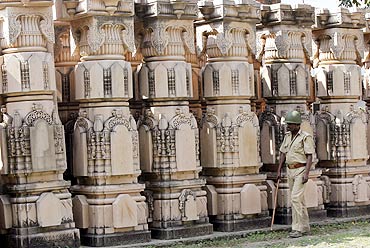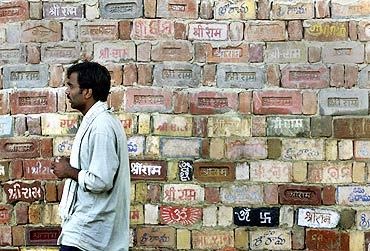
Kamal Farooqui, member of the All-India Muslim Personal Law Board and former chairperson of the State Minority Commission, believe the Ayodhya verdict gives all warring sides a golden opportunity to come to a settlement and end the vexed issue which has caused untold violence and harm to the Muslims. In a candid interview with rediff.com's Vrinda Gopinath, he addresses many of the perplexing issues and outlines a strategy for a final settlement.
The judgment has been criticised for giving a verdict on the existence of a Ram temple under the Babri mosque, and other historical issues, but these questions were listed in the Sunni Waqf Board petition. Why did the petitioner raise such issues in a title deed dispute?
I will say without hesitation that the Sangh Parivar's legal side outwitted us -- they were much smarter. Their legal side handled the case more Professionally; there was no one to help the Waqf side.
Some Muslim leaders derisively refer to the Waqf Board and its officials and lawyers like Jilani as a "sarkari' organisation and workers.
It's wrong to say this -- the Waqf Board is an autonomous body. However, I must admit the Waqf's case was mishandled and several issues like whether a temple existed, which ought not to have been included in the Waqf petition, suddenly came in. We were caught on the wrong foot.

How do you explain a situation that went so badly against the Muslim side?
The Waqf Board seems to have been manipulated right from the beginning. Since the time the petition was formulated, several issues seem to have crept in to deceive and betray the Muslim side. If the existence of a temple and its history were brought in the petition, the Archaeological Survey of India was manipulated to buttress the Sangh's version of history.
The ASI's report about the discovery of temple pillars during the Bharatiya Janata Party-led National Democratic Alliance rule came under sharp criticism from distinguished historians for its bogus and fraudulent claims. It was the latest in a series of trickery to construct and manufacture a new case.
Do you believe that Waqf Board Lawyer Zafaryab Jilani made a blunder or was he manipulated?
I am not a legal expert, but Jilani has to pay the price if he has done any wrong.
How can the All India Muslim Personal Law Board retrieve the situation? Can the organisation legitimately claim to represent the community in the country?
The AIMPLB was founded in 1973, and is the supreme umbrella organisation, which represents almost all Islamic schools of thought, philosophy and is acceptable to almost all Muslim organisations. The AIMPLB has 201 members, of which 101 are life members. We have been entrusted with protecting the Muslim Personal Law or the Sharia Application Act in India, liaise with and influence the government and guide the general public about crucial issues affecting the community.
We had a preliminary meeting of the Board in Delhi to analyse the high court bench's verdict in detail and prepare a set of recommendations for the working committee to study.

Several leading Muslim leaders have rubbished the verdict and want to appeal in the Supreme Court.
It's natural to have several differing voices. The most notable critics are the Shahi Imam Bukhari of the Jama Masjid, Delhi, the All India Muslim Women's Personal Law Board, and Asaddudin Owaisi of the All India Majlis-e Ittihad al-Muslimin. But we must not demonise the judges and cast aspersions on them.
The courts are our last resort. I still believe that even if Muslim litigants want to appeal in the Supreme Court, attempts to resolve the masjid-mandir issue between the two communities must continue simultaneously. The Lucknow bench verdict has given all three litigants a share of the disputed site and has thrown up 1001 possibilities for a compromise, which did not exist before the verdict. We must seize the opportunity or we will continue to be politically manipulated.
Is it just the British, or did successive Congress governments also politically manipulate the situation?
The British were responsible. The facts are in full view -- a mosque existed since 1528, where prayers were offered for almost 300 years.Then talks began around the mid-1800s about a Ram temple in Ayodhya, and the British gave the go-ahead to build a chabootra (canopy) outside the mosque, where Hindus offered prayers in the alleged birthplace of Lord Ram. It put Hindu-Muslim unity at peril, as the unity was threatening British rule, as was seen in the mutiny of 1857.
The move to construct a temple by the Nirmohis in the chabootra in 1883, were effectively foiled by the British. But on the midnight of December 22, 1949, some miscreants surreptitiously installed statues of Ram and Sita. It was a distressed Prime Minister Nehru who asked the Faizabad district magistrate to undo the wrong, which was ignored.

Could the Nehru government have been more coercive against the district administration?
The government was reeling after Partition. I do believe Nehru was a true secularist. The real culprit was then Uttar Pradesh chief minister Govind Ballabh Pant, who deliberately did not act on Nehru's orders. Not surprisingly, his son joined the Jan Sangh.
However, there is no doubt that Muslims have been stabbed in the back over the decades. After all, it was under Congress rule at the Centre when the idols were placed in 1949; the locks opened in 1985; the shilanyas (stone-laying ceremony) took place in 1987; the masjid was demolished in 1992; and the construction of a makeshift temple began under President's Rule in 1993.
You were part of the discussions with the Kanchi Shankaracharya in 2002. What were the solutions thrown up?
Both sides agreed there was no choice but to co-exist. The formula was loosely based on the fact that Hindus would exclusively get the chabootra (canopy) and the disputed 67 acres of land around it, and the Muslims would get the land under the three domes of the mosque. Unfortunately, the talks were scuttled by a powerful section of the Sangh Parivar.
And now what?
The latest judgment has not dispossessed any party, it is only the quantum of the share that has got the parties upset. The Rashtriya Swayamsevak Sangh has adopted a conciliatory tone, which is welcome, and I am confident we will arrive at a settlement. After this judgment, the Sangh Parivar cannot build the temple of their choice, as there are size constraints with a portion coming to Muslims to build a mosque too. The judgment is clear -- we have no choice but to co-exist.